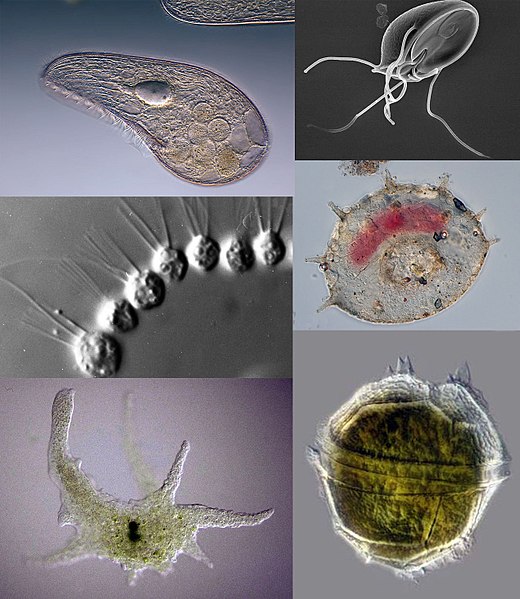The Radiolaria, also called Radiozoa, are protozoa of diameter 0.1–0.2 mm that produce intricate mineral skeletons, typically with a central capsule dividing the cell into the inner and outer portions of endoplasm and ectoplasm. The elaborate mineral skeleton is usually made of silica. They are found as zooplankton throughout the global ocean. As zooplankton, radiolarians are primarily heterotrophic, but many have photosynthetic endosymbionts and are, therefore, considered mixotrophs. The skeletal remains of some types of radiolarians make up a large part of the cover of the ocean floor as siliceous ooze. Due to their rapid change as species and intricate skeletons, radiolarians represent an important diagnostic fossil found from the Cambrian onwards.
Radiolaria
Anthocyrtium hispidum Haeckel
Like diatoms, radiolarians come in many shapes
Also like diatoms, radiolarian shells are usually made of silicate
Protozoa are a polyphyletic group of single-celled eukaryotes, either free-living or parasitic, that feed on organic matter such as other microorganisms or organic debris. Historically, protozoans were regarded as "one-celled animals".
Clockwise from top left: Blepharisma japonicum, a ciliate; Giardia muris, a parasitic flagellate; Centropyxis aculeata, a testate (shelled) amoeba; Peridinium willei, a dinoflagellate; Chaos carolinense, a naked amoebozoan; Desmarella moniliformis, a choanoflagellate
Class Protozoa, order Infusoria, family Monades by Georg August Goldfuss, c. 1844
John Hogg's illustration of the Four Kingdoms of Nature, showing "Primigenal" as a greenish haze at the base of the Animals and Plants, 1860
Frederick Chapman's The foraminifera: an introduction to the study of the protozoa (1902)








